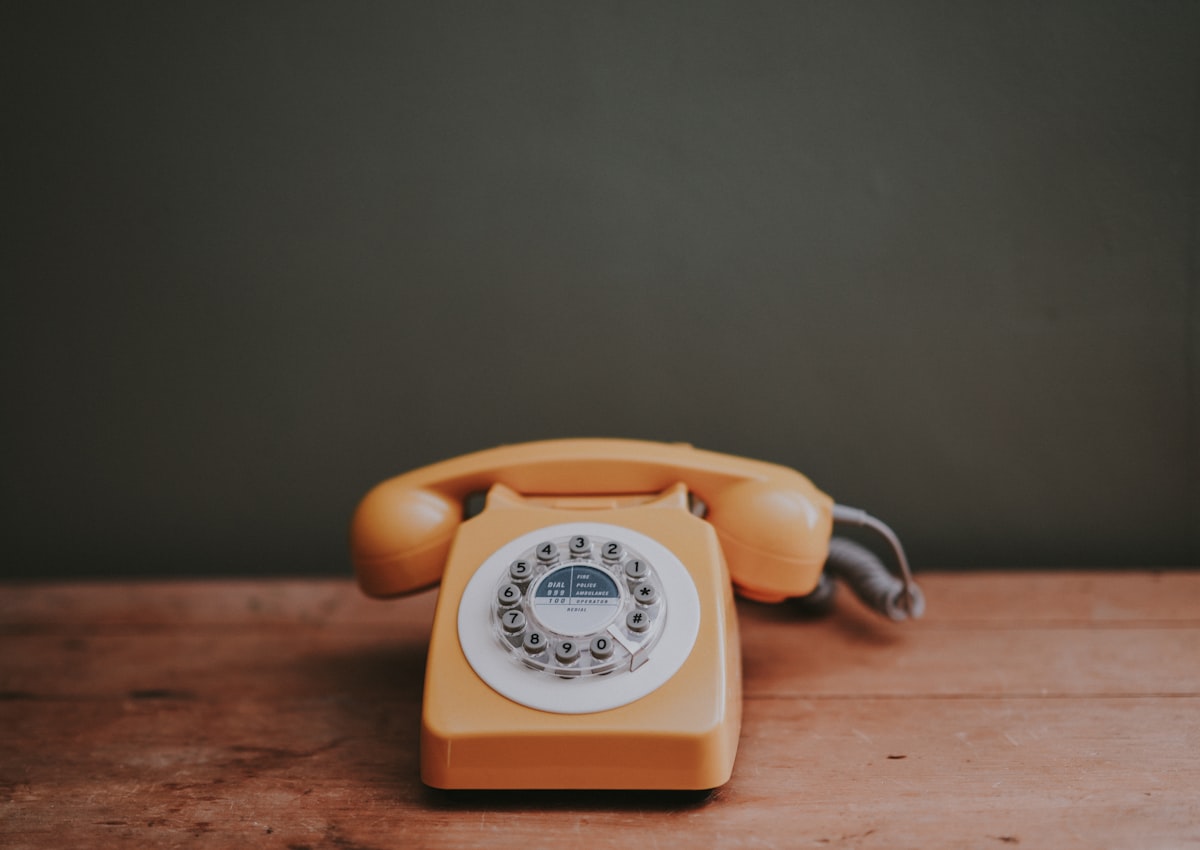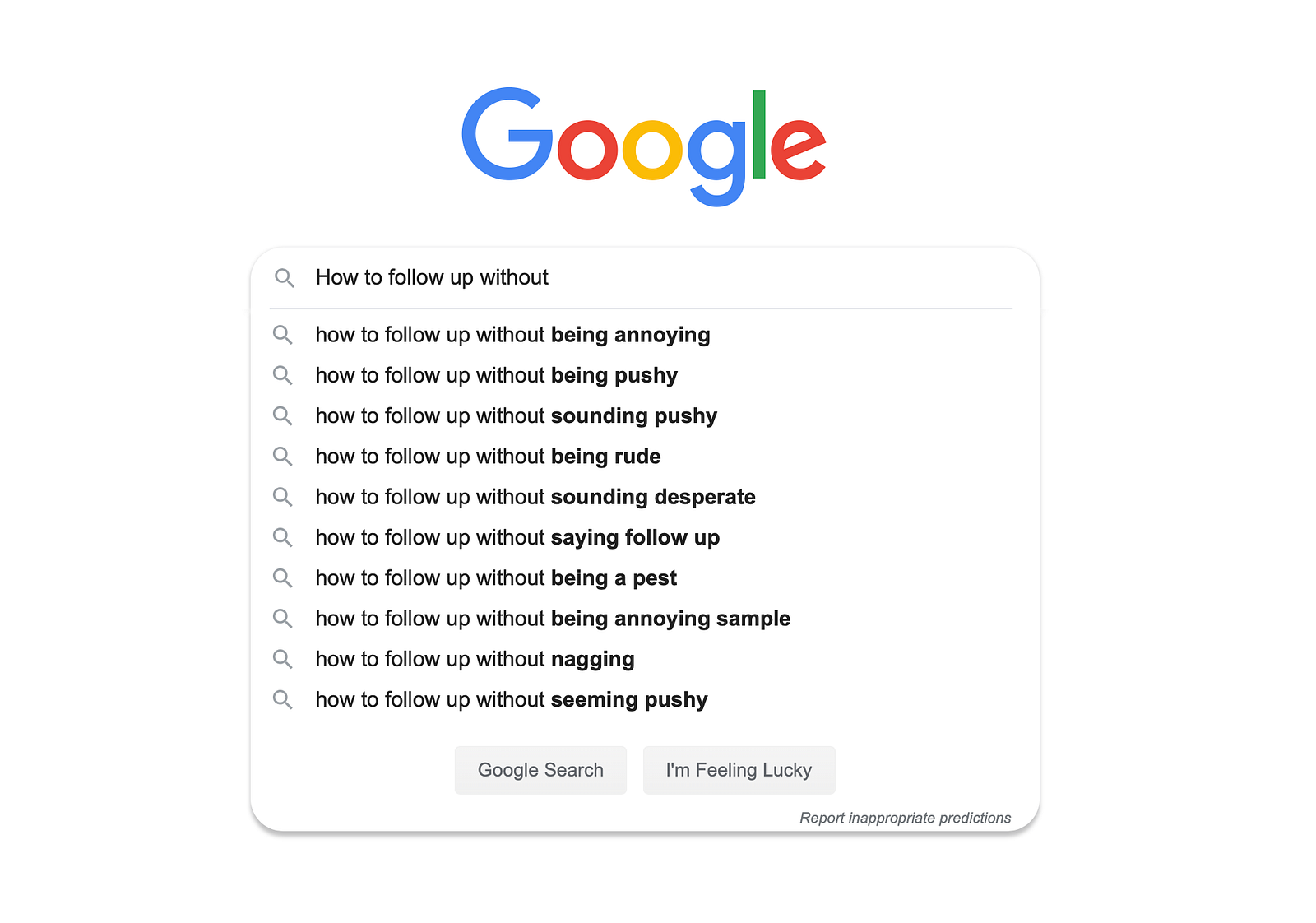How to Follow Up (without being annoying)
Featuring 15+ templates to help you follow-up.

This article was co-written by Celeste Fiorillo and Daniel Di Bartolo, two teammates with exceptionally Italian last names. Celeste manages projects for large software teams. Daniel is a PM and writes Curious, a newsletter for the inquisitive. It originally appeared in Product Management Insider.
Product managers collaborate with many people across the organization. Designers, developers, marketers, executives — in reality, the whole company.
While talking with our friends and colleagues in cross functional teams, we’ve noticed a shared challenge.
And that, my friends, is the art of the follow-up.
But What is The Follow-Up?
The follow-up is how you communicate when you need something from someone but they’re not getting back to you.
As product managers, we’re both givers and receivers of the follow-up. I have to follow-up with people across many teams and, at the same time, I create the need for people to follow up with me.
Everyone from junior product managers up to C-level have the need to give and receive follow-ups.
We’ve noticed something about the follow-up. For some people, the follow-up comes naturally. You’re comfortable doing it and the words come easy.
It might make others cringe, become uncomfortable, or raise stress levels. For some, it’s a learned skill that takes deliberate practice.

Can you relate?
“I haven’t heard back from them yet but I don’t want to seem like I’m nagging.”
“I need something but I don’t want to be annoying.”
“I have a question but they probably don’t have time to help me.”
“I don’t know the best way to get in touch with someone.”
“I don’t want to interrupt someone’s focus because I hate being interrupted myself.”
“I’ve already asked once and I don’t know how to ask again.”

With so many ways of communicating with each other, messages inevitably fall through the cracks — making the follow-up unavoidable.
The thing is, the follow-up is a necessity, and being comfortable with it will make you better at your job.
Avoiding it will result in slower projects, less growth, and balls being dropped.
Whether it comes naturally to you or if it’s not in your wheelhouse, we can all get better at the follow-up.
This post started out as an internal document to help our product teams grow this skill.
It really seemed to strike a nerve, and so we created this resource to help and inspire others to follow up more and to follow up with less stress and awkwardness.
Feel free to make these scripts your own or copy them.
We’ve broken it down into 2 sections:
- How to Follow Up With Your Coworkers
2. How to Follow Up With Your Manager
1. How to Follow Up With Your Coworkers
“Hi (name). I’m excited to work with you on (project, product, feature, campaign). What’s the best way to ask you questions or send you feedback?”
“Our spec review got me thinking… and I have some questions about it.
Question 1
Question 2
Question 3
What’s the best way to discuss these?
“Hi (name), I have a quick question for you on (the thing you have a question on). I’m actually working on this right now so if you have time to answer now, that would be helpful.
Here’s my question: (question)
If they don’t respond:
Is there someone else I could ask about this?
“Hey, I‘m working on (thing) and I’m running into some issues. Can I swing by your desk (or can we do a quick video call) in the next hour or so?
If not, is your calendar up to date so I can throw some time on it later today? I just need 10 minutes max.”
“Hi (name), hope you’re having a good week. I’m starting work on this (project, feature, bug) and I have a few questions for you:
Question 1
Question 2
Question 3
Can you get back to me on these by (date you need it by)? If not, what’s a realistic timeline? Let me know if I can clarify anything or if I can help with this in some way.”
“Hi (name). Have you had a chance to read the (email, text, Slack) message I sent you? I’m working on it right now and I’m blocked on moving forward until I hear back from you. Thanks for checking in on this for me — if I can help or if you have questions then let me know.
Hey, just following up on this. Since I haven’t heard back from you, I’m just going to do ______ unless I hear otherwise by (insert time).
I’m starting to work on ______. I have some questions about the spec.
(Insert questions)
I know they might sound nit-picky but the details really matter here and have a big impact on the cost.
If we make some changes to the spec we could do it cheaper or better because _____.”
Here’s a good one if you’re getting total radio silence. Use sparingly. This is a nuclear option. Send them an email.
Include only “Have you given up on this?” in the subject line.
I’ve only had to use this one or two times. It works like magic.
We stole this from Chris Voss and his book, Never Split the Difference.
“I’m sure you have a lot of other priorities above this, is there [a manager] I can talk to to help allocate some of your time to this?”
This can be really effective if you’re swooping in on the side with a team you don’t usually work with. People can be hesitant to give you their time (rightfully so) if their manager isn’t in the loop.
Even better — start with the team lead/manager and ask who can help you with your problem/question/inquiry. You’re more likely to get help because everyone’s on the same page.
“If you don’t have time to help me with this before [date], could you point me to someone else who might?”
I’d like to learn more about [subject]. Can I buy you coffee/lunch in the next few weeks to learn from you about it?
“Is there anything I can help with or take off your plate to give you time to think about this?”
Not in a manipulative, fake-flattery way, but everyone can always use more encouragement; they want to be seen as individually significant, and not just a cog in a machine. Let them know why you’re reaching out to them and why you need their help.
“You’re seen as the expert in . . .”
“You did a great job on project x.”
“You have great attention to detail and I’d love more of that on this project.”
“I’d like to learn from you . . .”
2. How to Follow Up With Your Manager
All of those stressful feelings you might have about following up are amplified when it’s with your manager.
Maybe your manager didn’t answer your email. Or the VP didn’t respond to your proposal. Or you can’t ship the new feature because you haven’t received sign-off from the Design Director.
Progress has halted because the ball is in someone else’s court. It’s up to you to own the problem and follow up.

Before you tell yourself that their silence is a sign they don’t care about you or your product, keep in mind that managers can be busy, forgetful, distracted — just like everyone else you follow up with.
As a manager, I can tell you that I love when my team follows up with me. It shows me that they’re taking responsibility for their work and that they’re not going to let anything (even me!) slow them down. They’re gracious when I have to say “not yet” or “ask me again next week,” but they are relentless in getting themselves unblocked.
Three Principles for Following up With Your Manager
1.Know your manager’s communication style. What’s the best way to reach them? Where are they most likely to respond? Personally, I don’t retain verbal tasks well. If you remind me in the hallway to look at your proposal, I’ll likely forget before I get back to my desk. An instant message is the best way to follow up with me. I have a manager who communicates best in person, so I gather up my list of questions and schedule 15 minutes to go rapid fire through my list with him. Another manager is great with email — I know I can expect a response within a day.
2.Use their time well. We all know the very real cost of switch-tasking. Managers have a lot of people reaching out about lots of things — the interruptions can get overwhelming. You can help by consolidating your requests. Unless your follow-up item is especially urgent, start a list of follow-ups for your manager. Then bring your list to your next 1-on-1, or schedule time to go through it. Rather than causing your manager to switch-tasks 10 times, now you can knock out 10 follow-ups in a matter of minutes.
3.Come with questions and answers. When you’re following up with a manager, you might be looking for their approval on something, asking how to handle a certain situation, or wanting direction for a project. Ask your question but also present your own thoughts on how to handle it; whether the quality is high enough to ship, which direction the company should go next. Asking them shows you value and respect their input. Coming with answers shows your value.
Here are a few more templates that you can use to follow up with your manager.
“I need help figuring out [problem]. When do you have time to help me with that?”
“[Project] has a due date of [date], but I’m blocked on progressing until I hear back from you. Do you have time to help me soon, or is it okay if I push out the due date?”
“I would like your advice in handling [situation]. Do you have an opinion on that or do you want me to figure it out on my own?”
“I’m going to move forward with [option] unless I hear back from you before [date].”
“I’m stuck on [problem]. I think we should solve it by [solution]. Do you agree that’s the right approach?”
The Art of the Follow-Up is Hard
Finding the right words to follow-up can be really hard. Our hope is that you’d use this resource as a tool-kit for those moments when you don’t know what to say.
If someone on your team struggles with the follow-up, consider passing this along.
